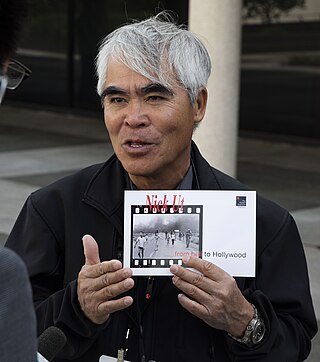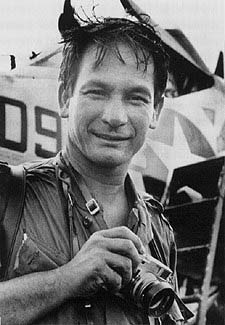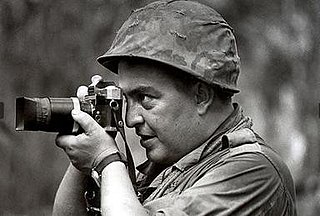Related Research Articles

The Pulitzer Prize for Breaking News Photography is one of the American Pulitzer Prizes annually awarded for journalism. From 2000 it has used the "breaking news" name but it is considered a continuation of the Pulitzer Prize for Spot News Photography, which was awarded from 1968 to 1999. Prior to 1968, a single Prize was awarded for photojournalism, the Pulitzer Prize for Photography, which was replaced in that year by Pulitzer Prize for Spot News Photography and Pulitzer Prize for Feature Photography.

The Sabra and Shatila massacre was the 16–18 September 1982 killing of between 1,300 and 3,500 civilians—mostly Palestinians and Lebanese Shias—in the city of Beirut during the Lebanese Civil War. It was perpetrated by the Lebanese Forces, one of the main Christian militias in Lebanon, and supported by the Israel Defense Forces (IDF) that had surrounded Beirut's Sabra neighbourhood and the adjacent Shatila refugee camp.

The Kataeb Party, officially the Kataeb Party – Lebanese Social Democratic Party, also known as the Phalanges, is a right-wing Christian political party in Lebanon founded by Pierre Gemayel in 1936. The party and its paramilitary wings played a major role in the Lebanese Civil War (1975–1990), opposing Palestinian forces in the country as well as collaborating with Israel. Pierre's youngest son Bachir, the leader of the party's militia, was elected President in 1982, but was assassinated before he could take office. He was succeeded by his older brother Amine, who led the party through much of the war. In decline in the late 1980s and 1990s, the party slowly re-emerged in the early 2000s and is currently part of the Lebanese opposition. The party currently holds 4 out of the 128 seats in the Lebanese Parliament.

Elie Hobeika was a Lebanese Maronite militia commander in the Lebanese Forces militia during the Lebanese Civil War and one of Bashir Gemayel's close confidants. After the murder of Gemayel, he gained notoriety for his direct involvement in, and overseeing of, the 1982 Sabra and Shatila massacre. Hobeika initially supported the IDF during their invasion, but later switched sides and supported the Syrians. He became president of the Lebanese Forces political party until he was ousted in 1986. He then founded the Promise Party and was elected to serve two terms in the Parliament of Lebanon. In January 2002, he was assassinated by a car bomb at his house in Beirut, shortly before he was to testify about the Sabra and Shatila massacre in a Belgian court.

Huỳnh Công Út, known professionally as Nick Ut, is a Vietnamese-American photographer who worked for the Associated Press in Los Angeles. He won both the 1973 Pulitzer Prize for Spot News Photography and the 1973 World Press Photo of the Year for his 1972 photograph The Terror of War, depicting children running away from a napalm bombing attack during the Vietnam War. In 2017, he retired. Examples of his work may be found in the collection of the National Gallery of Art in Washington, DC.

The Kahan Commission, formally known as the Commission of Inquiry into the Events at the Refugee Camps in Beirut, was established by the Israeli government on 28 September 1982, to investigate the Sabra and Shatila massacre. The Kahan Commission was chaired by the president of the Supreme Court, Yitzhak Kahan. Its other two members were Supreme Court Judge Aharon Barak, and Major general (res.) Yona Efrat. The Commission was to make recommendations on Israeli involvement in the massacre through an investigation of:
[A]ll the facts and factors connected with the atrocity carried out by a unit of the Lebanese Forces against the civilian population in the Shatilla and Sabra camps.

The Pulitzer Prize for Photography was one of the American Pulitzer Prizes annually awarded for journalism. It was inaugurated in 1942 and replaced by two photojournalism prizes in 1968: the Pulitzer Prize for Feature Photography and "Pulitzer Prize for Spot News Photography", which was later renamed Pulitzer Prize for Breaking News Photography in 2000.

Henri Huet was a French war photographer, noted for his work covering the Vietnam War for the Associated Press (AP).

Horst Faas was a German photo-journalist and two-time Pulitzer Prize winner. He is best known for his images of the Vietnam War.
The following are the Pulitzer Prizes for 1983.

The Shatila refugee camp, also known as the Chatila refugee camp, is a settlement originally set up for Palestinian refugees in 1949. It is located in southern Beirut, Lebanon and houses more than 9,842 registered Palestine refugees. Since the eruption of the Syrian Civil War, the refugee camp has received a large number of Syrian refugees. In 2014, the camp's population was estimated to be between 10,000 and 22,000.
Bilal Hussein is an Iraqi Associated Press photojournalist based in Fallujah, Iraq. He was arrested in Ramadi by U.S. forces in April 2006 and detained on suspicion of aiding insurgents in Iraq. He was taken into custody to face charges in the Iraqi Central Court, reportedly over the circumstances of his photos, which were supplied by the U.S. military. American and Iraqi governments were criticized for violating the Geneva Conventions, and for detaining Hussein without evidence. He was finally released without charge in 2008. That year, Hussein won an International Press Freedom Award.
Neal Hirsh Ulevich is an American photographer. He won a Pulitzer Prize in 1977 for "photographs of disorder and brutality in the streets of Bangkok".
Khalil Hamra is an Arab photojournalist based on Rafah in the Gaza Strip. In 2009, Hamra was recognized by the Overseas Press Club of America with its 2010 Robert Capa Gold Medal for his series covering the war in Gaza.
Cary Vaughan is an American English language instructor and journalist best known for her role in the Terry A. Anderson hostage crisis in Lebanon.
Karsten Thielker was a German Pulitzer Prize–winning photographer and journalist. He focused primarily on exhibition design, photography and photojournalism.
Manu Brabo is a Spanish photojournalist who was captured in Libya along with three other journalists while covering the Libyan Civil War in 2011 and who was part of the Associated Press team to win the Pulitzer Prize for Breaking News Photography in 2013.
Abdul Rahman Katanani is a Palestinian sculptor. He was born and living in Sabra refugee camp near Beirut, Lebanon. Katanani is a third generation Palestinian refugee; his grandparents left Yazour—a small town now called Azor—in Jaffa during the 1948 Palestinian exodus.
Janet Lee Stevens was an American journalist, human rights advocate, translator, and scholar of popular Arabic theater. She lived in Beirut during the Lebanese Civil War and chronicled the experiences of Palestinian refugees before and after the Sabra and Shatila Massacre of September 16–18, 1982.
Emilio Morenatti is a Pulitzer Prize winning Spanish photojournalist, working for the Associated Press since March 2004.
References
- 1 2 "Spot News Photography". The Pulitzer Prizes. Retrieved 30 October 2013.
- 1 2 "Today in photo history – 1982: Massacres at Sabra and Shatila refugee camps in Lebanon". The Dallas Morning News (dallasnews.com). 16 September 2012.
- 1 2 3 4 5 6 Foley, Bill. "Bill Foley Photography". billfoley.com. Archived from the original on 2 July 2012. Retrieved 3 June 2011.
- ↑ "IU School of Journalism's spring speaker series to features alumni panels". Indiana University. 23 February 2011. Retrieved 3 June 2011.
- ↑ Foley, Bill (2006). "The Last Smile". billfoley.com. Archived from the original on September 10, 2011. Retrieved 3 June 2011.
- ↑ "Neighborhood Report: Museum Mile; Renewal in Black and White". The New York Times. 16 July 2010. Retrieved 3 June 2011.
- ↑ Foley, Bill (2011). "The Pulitzer Series: The Chatilla Massacre". billfoley.com. Archived from the original on 24 March 2012. Retrieved 3 June 2011.
- ↑ "Journalists Receive 1996 Press Freedom Awards". Committee to Protect Journalists. 1996. Archived from the original on 3 June 2011. Retrieved 28 May 2011.
- ↑ "2 Journalists are honored for championing free press". The Robesonian. Associated Press. 30 October 1991. Retrieved 3 June 2011.
- 1 2 "William Foley". Marion University. Archived from the original on 26 July 2011. Retrieved 28 May 2011.